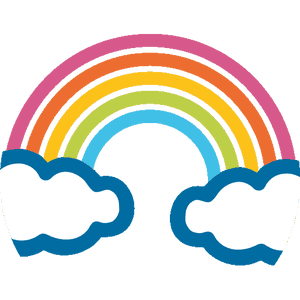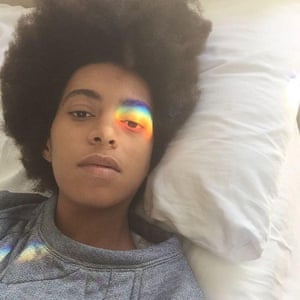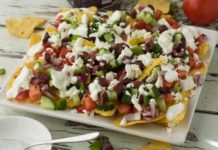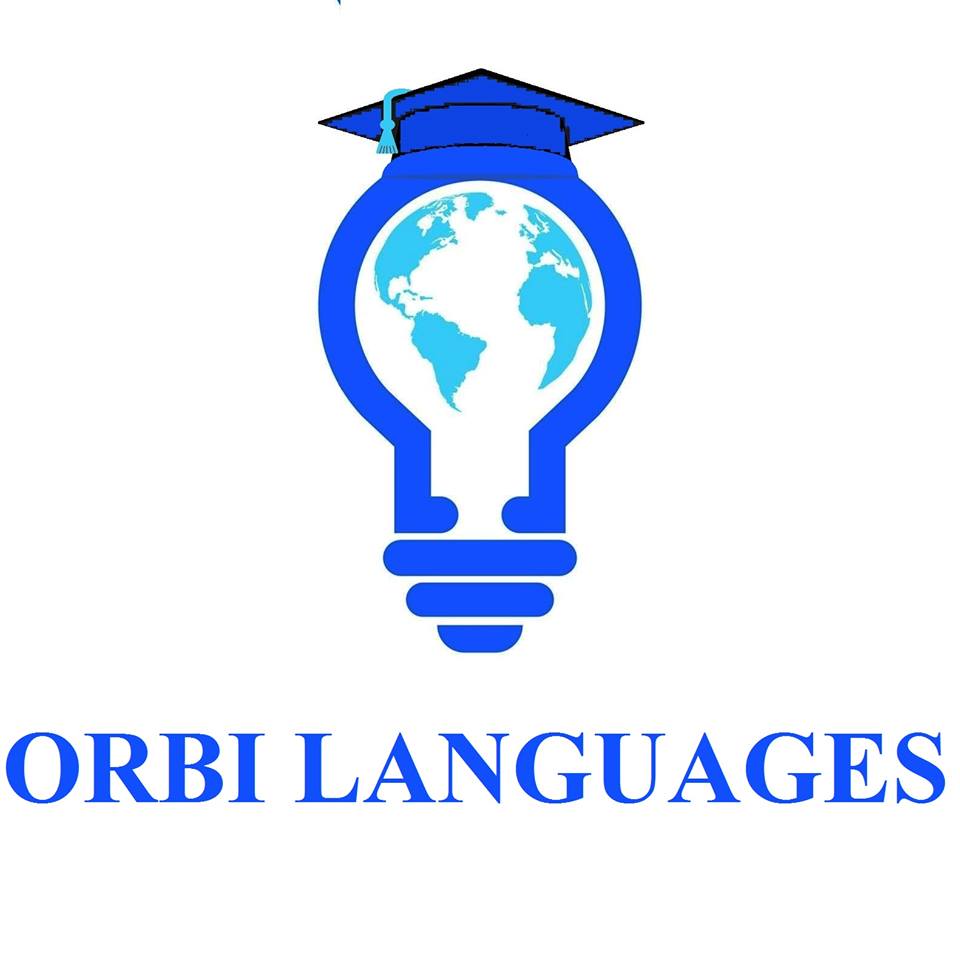The rainbow’s not over – it’s the style symbol of the season
Lauren Cochrane
From phone cases to Gucci flatforms and cakes to Vans sweatshirts, this multi-coloured shot of magic and LGBT freedom is a visual pot of gold for uncertain times.
Forget flamingos, cacti, pineapples and love hearts. The symbol set to sum up summer 2017 is the rainbow – sure, occasionally the natural one in the sky, but more often the cartoon-ified version, as seen on emoji keyboards.

The rainbow emoji. Photograph: Android
Versions of the emoji rainbow can be seen on phone cases (Stella McCartney), jumpers (Urban Outfitters), blouses and sweatshirts (Vans). Asos has over 100 rainbow-related items and Selfridges’ director of accessories, Eleanor Robinson, calls the rainbow “hard to miss, upbeat summer fashion at its best”. She points to Gucci flatforms with rainbow soles and a Marc Jacobs backpack, and you could also add Lupita Nyong’o’s rainbow-hued Balmain crochet dress. Tabitha Webb’s rainbow blouses, meanwhile, are a bestseller, and TV gold worn by Holly Willoughby and Fearne Cotton.

Urban Outfitters’ rainbow heart motif jumper. Photograph: Urban Outfitters
While a real rainbow is a rare shot of magic across the sky, emoji-type rainbows are never far from your smartphone screen. Under food-meant-for-Instagram, file Mean Girls-worthy rainbow cakes, rainbow bagels and now rainbow churros. Then there are rainbow filters – actually the refraction of a rainbow across selfies from blogger Chiara Ferragni and singer Solange Knowles. For hair, there’s Insta-friendly rainbow roots. Blondies, a hairdresser in Melbourne, has started a trend to dye the first five centimetres of a client’s hair in all the colours of the rainbow.

Solange Knowles’s Instagram rainbow filter selfie. Photograph: Instagram/saintrecord

Holly Willoughby wearing a Tabitha Webb rainbow blouse on This Morning in January 2017. Photograph: Ken McKay/ITV/Rex/Shutterstock
Rainbows have appeared everywhere from Pink Floyd’s Dark Side of the Moon in 1973 to the old Apple logo from 1976, the text on the cover of Daft Punk’s Discovery in 2001 and Paul Smith’s signature rainbow-like stripes. But what is it about rainbows that make them a visual pot of gold in 2017?
Well, they’re resolutely, irresistibly cheery in a grin-like-a-six-year-old way. In dark times, the Disney-ish magic of a rainbow is exactly what we need. “No one can say no to a rainbow and no one can stay miserable when faced with a rainbow,” says Tabitha Webb. “I wore one of my dresses with a rainbow print in New York last year and I was stopped eight times.”
“They’re a symbol of fun, luck and positivity, something people are seeking as we face uncertain climates,” adds Vanessa Spence, design director of Asos. She says they’re going to be big news over the festival season.
Maks Fus Mickiewicz from the trend forecasting agency The Future Laboratory, sees the roots of this in the late-noughties Tumblr seapunk culture – all mermaids, dolphins, unicorns and rainbows. It’s an aesthetic that musicians including Grimes, Katy Perry and Nicki Minaj have all played with. “It was a natural reaction to the recession,” he says. “If you can’t change your natural environment, the geopolitical situation that surrounds you, then you create your own world.”
Of course, the 2010s aren’t the first decade to embrace the rainbow. Fashion and culture is still totally stuck in the 70s and early 80s. The rainbow formed an arch across that time period too – as both Apple and Pink Floyd suggest. Think of those classic 70s roller skates with rainbow colours flanking the laces, rainbow legwarmers, or the rainbow-colour-patterned backdrop of that famous BBC test card, starring eight-year-old Carole Hersee playing noughts and crosses. Rainbows are in Skittles’ long-running “taste the rainbow” campaign. Gucci designer Allessandro Michele, fashion’s maximalist of the moment, loves the 70s and has produced rainbow stripes throughout his tenure – from those flatforms to Alexa Chung’s jumper – symbolising a childlike desire for all the colours, all at once.

Pink Floyd’s Dark Side of the Moon album cover, 1973. Photograph: Alamy
Rainbows come with a more explicit symbolism too: that of the LGBT freedom flag. Created by Gilbert Baker in 1978, after encouragement from Harvey Milk, the flag was designed to represent the diversity of the gay community. Nearly 40 years later, it’s the only flag to have been bought by New York’s Museum of Modern Art, its colours have been projected on the White House and last year it even became an emoji. In 2015, Facebook users added the rainbow flag filter to their profile picture to show their support for gay marriage. While Baker died last month, his flag’s symbolism has been revitalised in Trump’s America, adopted as shorthand for all-colours-of-the-rainbow inclusivity. After the 2016 American election, the Museum of Modern Art, in New York, displayed the flag in its entrance hall as a message of tolerance. There’s also a rainbow-coloured pedestrian crossing coming to Totnes in Devon and a Black Lives Matter T-shirt.

The Reykjavik Pride 2014 parade. Photograph: Alamy
Sure, it’s a stretch to think that using an emoji rainbow in a text makes a tangible impact in supporting the rights of minorities, but the rise of the rainbow after the Brexit vote and Trump’s election can’t be a complete coincidence. Fus Mickiewicz calls them “a natural resistance”. Rain leads to rainbows, which makes them a natural metaphor for good things coming out of bad – and that makes them exactly the spirit of cheer, and the symbol of inclusivity, that we need. And they look really great on Instagram.










